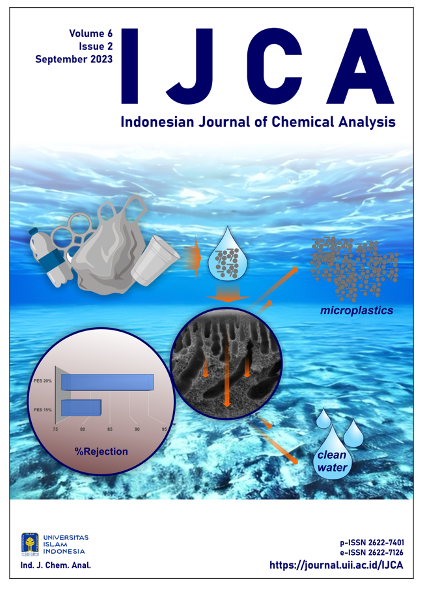Main Article Content
Abstract
The Company's input pipes contained microplastics, per the preliminary test findings. While the water yield produced by PDAM Tirta Daroy contains 150 particles/L, the Tirta Daroy Drinking Water Area has 275 particles/L. Microplastics found in the water pose a major risk to living beings if they are consumed. This work aims to characterize the properties, flux, and polyethersulfone (PES) membrane rejection coefficient, which were made utilizing the phase inversion technique with a solvent and additives called N,N-dimethylformamide (DMF). In Sungai Krueng Aceh, titanium dioxide (TiO2) is utilized to filter out microplastics from the water. Results of Scanning Electron Microscopy (SEM) examination of Membrane Morphology demonstrate that the resulting membrane is an asymmetrical membrane of two layers, the upper layer relatively thin and the lower layer porous. When compared to the PES membrane when it was 15% DMF/TiO2, the 20% DMF/TiO2 membrane exhibits a finger-like cross-sectional structure called a macrovoid) with more and larger numbers. Analysis of the microplastic rejection coefficients proved the effectiveness of PES, DMF, and TiO2 membranes in removing microplastics. Results of tests on the effectiveness of rejecting microplastics after undergoing process filtration with a microplastic rejection coefficient of 94% and 14.2 particles/L utilizing a 20% PES/DMF/TiO2 membrane Performance of PES membranes: The PES membrane with 20% DMF/TiO2 has a water flux of 0.467 L/m2.hour compared to 15% DMF/TiO2 0.733 L/m2.hour. This study's findings on membrane Ultrafiltration have the potential to be used as a water filter standard in PDAM.
Keywords
Microplastics
Polyethersulfone
Flux
Rejection coefficient
Membrane
Article Details

This work is licensed under a Creative Commons Attribution-ShareAlike 4.0 International License.
How to Cite
Dzihninafira, H. ., Hamdan, A. M., & Razi, F. (2023). Microplastic Removal in Krueng Aceh River Water Using Ultrafiltration Membrane from Polyethersulfone Polymer (PES). Indonesian Journal of Chemical Analysis (IJCA), 6(2), 151–163. https://doi.org/10.20885/ijca.vol6.iss2.art7




